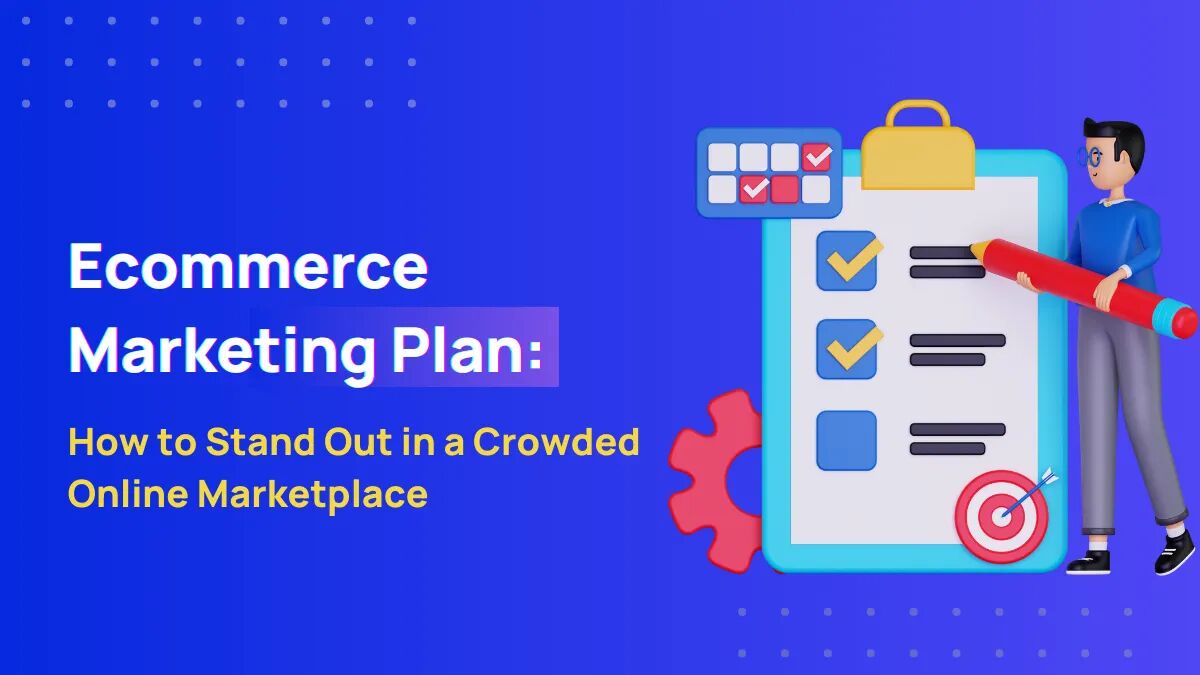The world of ecommerce is a battleground, a place where only the strongest and most strategic warriors can survive. With millions of online stores vying for consumer attention, it takes more than just a flashy website and a handful of products to make it in this cutthroat landscape.
To emerge victorious, you need a winning ecommerce marketing plan that will set you apart from the competition and attract customers to your digital storefront like moths to a flame.
In this blog post, we’ll explore the essential elements of a successful ecommerce marketing plan and show you how to create a strategy that will help you conquer the ecommerce arena once and for all.
So sharpen your swords and tighten your armor, because the battle for online supremacy is about to begin.
Table of Contents
What is an Ecommerce Marketing Plan?
An ecommerce marketing plan is a strategic document that outlines the steps you’ll take to promote your online store and drive sales. It should include everything from identifying your target audience and unique selling proposition to selecting the right marketing channels and measuring your success.
Why is an Ecommerce Marketing Plan Important?
- Having a well-crafted ecommerce marketing plan is like having a GPS system in your car. It helps you stay on track and avoid getting lost in the sea of competition.
- By targeting the right audience with the right message at the right time through the right channels, you can maximize your chances of success and achieve your business goals.
- A well-crafted ecommerce marketing plan also allows you to measure your progress and adjust your strategy as needed to optimize your ROI and continue to see growth and success.
Ecommerce Marketing Plan: Key Components
Research and Analysis

- Conduct a SWOT analysis to identify the strengths, weaknesses, opportunities, and threats of your eCommerce brand in the market.
- Look for strengths like high-quality products, a loyal customer base, or competitive pricing. Identify weaknesses like poor website interface, low brand recognition, or limited resources.
- Explore opportunities like new product launches, emerging trends, or untapped markets. Identify potential threats such as new competitors, economic downturns, or changes in consumer behavior.
Setting Goals and Objectives
- Defining your marketing goals is like setting a destination for a road trip. You need to know where you’re going before you start driving.
- SMART objectives are specific, measurable, achievable, relevant, and time-bound. They help ensure that your efforts are focused and effective.
- For example, if your goal is to increase website traffic by 20% over the next six months, your SMART objectives might include launching an email campaign to grow your subscriber list by 10%, running a Facebook ad campaign to generate 500 new leads per month, or optimizing your website for better search engine rankings.
Developing a Marketing Strategy
- Creating a value proposition is like building a foundation for your house. It’s the basis upon which everything else rests.
- A value proposition should answer the question, “Why should someone buy from me instead of my competitor?” It should be clear, concise, and compelling.
- Choosing the right marketing channels is like selecting the right tools for a job. You wouldn’t use a hammer to tighten a screw.
- Some popular marketing channels for ecommerce include social media, email, SEO/SEM, PPC advertising, and influencer marketing. The key is to choose the channels that resonate with your target audience and align with your business goals.
Implementing Your Marketing Plan

- Creating a marketing calendar is like plotting out a flight plan for a pilot. It helps ensure that you’re on course to reach your destination.
- A marketing calendar should include all of your campaigns and tactics, along with their associated deadlines and milestones.
- Developing a social media strategy is like throwing a party. You want to create an atmosphere that’s inviting, engaging, and fun for your guests.
- A social media strategy should include a posting schedule, content themes, and engagement tactics.
- Launching email marketing campaigns is like planting seeds in a garden. You need to nurture them regularly to help them grow.
- An email marketing campaign should include a series of automated emails that provide value to your subscribers, such as special offers, educational content, or product updates.
- Optimizing your website for SEO and SEM is like building a highway to your store. You want to make it easy for people to find you.
- SEO involves optimizing your website for search engine rankings through keyword research, on-page optimization, and link-building strategies. SEM involves running paid ads on search engines to drive targeted traffic to your site.
- Running PPC advertising campaigns is like turning on a faucet. You can control the flow of traffic to your site with the flip of a switch.
- PPC advertising involves creating ads that appear on search engines or social media platforms and paying for clicks or impressions. It’s a great way to get targeted traffic quickly.
- Leveraging influencer marketing is like hiring a celebrity spokesperson. You’re tapping into someone else’s trusted relationship with their followers to promote your brand.
- Influencer marketing involves partnering with social media influencers who have large followings in your niche to promote your products or services.
Measuring Your Success
- Setting up analytics tracking is like installing a GPS system in your car. It helps you track where you’ve been and where you’re going.
- Analytics tracking involves setting up tools like Google Analytics or Facebook Pixel to monitor your website traffic, conversions, and other key metrics.
- Measuring your KPIs is like taking your temperature. It gives you a read on your overall health and well-being.
- Some common KPIs for ecommerce include website traffic, conversion rates, average order value, and customer retention rate.
- Analyzing your results is like looking in the mirror. It helps you see what’s working and what’s not.
- Based on your findings, you can adjust your strategy as needed to optimize your ROI and continue to see growth and success.
Download Now: Free Marketing Plan Template
Ecommerce Marketing Plan Example: How it looks
Here is an example of the marketing plan for a real-life Clothing brand selling bamboo t-shirts:
| Marketing Objective | Strategy | Tactics | Target Audience | Metrics | Example |
| Research and Analysis | Conduct SWOT Analysis | Identify strengths, weaknesses, opportunities, and threats in the marketplace. | Internal stakeholders, industry experts, market research data | Completed SWOT analysis report | Conducted SWOT analysis on “Bamboo Apparel,” a clothing brand selling sustainable fashion made with bamboo fabric. |
| Setting Goals and Objectives | Set SMART Objectives | Set specific, measurable, achievable, relevant, and time-bound goals. | Increase website traffic by 20% over the next six months through email campaigns to grow the subscriber list by 10% and Facebook ads campaign to generate 500 new leads per month. | Monthly website traffic report, email campaign conversion rates, Facebook ad engagement metrics | Set SMART objectives for Bamboo Apparel based on their business goals and target audience. |
| Developing a Marketing Strategy | Create a Value Proposition & Select Marketing Channels | Develop a clear, concise, and compelling value proposition and select appropriate marketing channels based on the target audience and business goals. | Eco-conscious millennials and Gen Z interested in a sustainable fashion; social media (Facebook, Instagram, Twitter), email marketing, SEO/SEM, PPC advertising, influencer marketing | Social media follower growth, email open and click-through rates, organic search traffic, PPC ad impressions and conversions, influencer engagement metrics | Bamboo Apparel’s value proposition is “Sustainable Fashion Made Easy” and they use various marketing channels to reach out to their target audiences such as Facebook, Instagram, Twitter, Email marketing, SEO/SEM, PPC advertising, and influencer marketing. |
| Implementing Your Marketing Plan | Create Marketing Calendar & Tactics | Create a marketing calendar with all campaigns and associated deadlines/milestones and implement tactics (social media posting schedule/content themes/engagement tactics, automated email campaigns, SEO/SEM optimization, PPC ad creation and management, influencer outreach/partnerships). | Potential and existing customers | Marketing calendar completion rate, social media engagement metrics, email campaign performance, search engine ranking improvements, PPC advertising ROI, influencer partnership success metrics | With their marketing plan in place, Bamboo Apparel creates a marketing calendar and implements tactics such as posting regular content on social media, sending out personalized emails to subscribers, optimizing their website for SEO and SEM, creating engaging PPC ads, and partnering with influencers in the sustainable fashion niche. |
| Measuring Your Success | Analytics Tracking & KPIs | Set up analytics tracking to monitor website traffic, conversions, and other key performance indicators (KPIs) such as website traffic, conversion rates, average order value, and customer retention rate. | Website visitors and customers | Analytics tracking set up, monthly KPI reports, conversion rate optimization progress, customer retention rate, lifetime customer value | Bamboo Apparel tracks its marketing efforts using various KPIs and analytics tools such as Google Analytics and Facebook Pixel. They monitor their website traffic, conversion rates, average order value, and customer retention rate to measure their success and make necessary changes to their marketing plan. |
This example is fictional and is used for illustrative purposes only. The strategies and tactics mentioned in the table can be customized based on the specific needs and goals of the Clothing brand selling bamboo t-shirts.
Key Takeaways
As the sun sets on my workday, I reflect on the journey of writing ‘creating a winning ecommerce marketing plan’. I know, It’s not easy to make one, but if you follow these key components, you’ll be well on your way to driving more traffic, generating more leads, and increasing sales for your online store.
A marketing plan is like a detailed road map that outlines the specific steps you’ll take to achieve your goals and objectives. On the other hand, a marketing strategy is a broader approach to achieving those goals – it’s like your overall game plan.
Conducting a SWOT analysis is critical in identifying your strengths, weaknesses, opportunities, and threats. It helps you set your business apart from the competition by fine-tuning your marketing strategy to better serve your customers.
Your unique selling proposition is what makes your brand stand out from the rest. To find yours, think about what sets your product or service apart, how it solves problems, and why customers should choose you over other options.
A value proposition is essential in ecommerce marketing because it explains why someone should buy from you. It differentiates your brand from the competition and communicates your unique selling proposition to potential customers.
Measuring your KPIs and analyzing your results is critical to determining whether your ecommerce marketing efforts are paying off. It’s like checking your progress during a long race, making sure you’re still on track to reach your destination.
Deciding whether to hire a marketing agency or do it yourself depends on your resources, expertise, and budget. If you have the skills and resources to create a successful marketing plan, go for it! However, if you’re unsure, a marketing agency can help you achieve better results.
Finally, there are some common mistakes to avoid in ecommerce marketing planning. Targeting the wrong audience, failing to create a strong value proposition, not optimizing your website for SEO and mobile, and neglecting to measure your results are all pitfalls you’ll want to steer clear of.
In conclusion, creating a winning ecommerce marketing plan requires hard work, but it’s worth it. By following these key components, you can build a strong foundation for your business and achieve your goals. You’ve got this – go for it!
